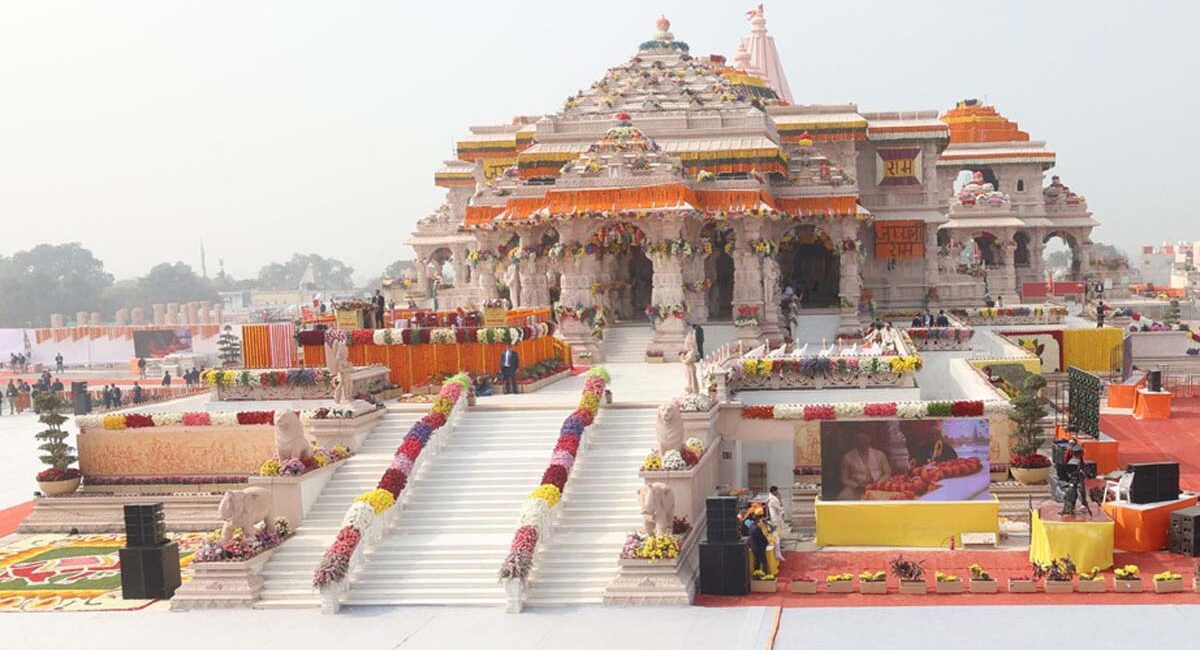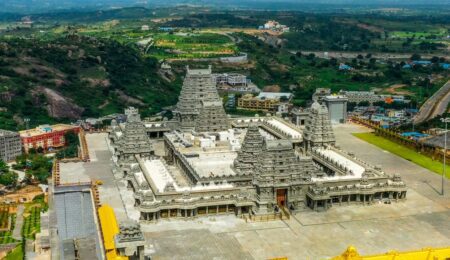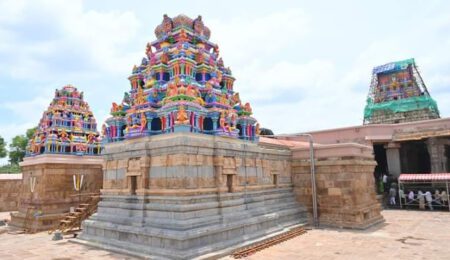Ram Mandir Ayodhya: History, Construction, and Spiritual Significanc
Introduction: The Symbol of Eternal Devotion
The Ram Mandir Ayodhya is more than just a temple. It is the collective heartbeat of a billion believers—a sacred shrine representing devotion, dharma, and resilience. Located on the serene banks of the Sarayu River, the temple is built at the birthplace of Bhagwan Shri Ram, the seventh incarnation of Lord Vishnu.
The temple’s foundation was laid not just in the soil of Ayodhya but in the faith of millions, etched in centuries of cultural memory and spiritual yearning.
Ayodhya: The Sacred Birthplace of Lord Ram
Ayodhya, one of the seven Mokshapuris, is considered among the holiest cities in Hinduism. The Ramayana, written by Maharishi Valmiki, places Ayodhya as the capital of the Ikshvaku dynasty, ruled by King Dasharatha. It is here that Lord Ram was born and where his divine journey began.
The spiritual aura of Ayodhya is timeless. Saints, sages, and pilgrims have revered this city as the gateway to liberation (moksha).
The Ancient History of Ram Janmabhoomi
Historical records, religious scriptures, and archaeological evidence point to the existence of a Ram temple at the site for centuries. Ancient travelers, inscriptions, and local traditions consistently affirmed that a shrine to Lord Ram existed in Ayodhya long before foreign invasions.
This temple served as a powerful symbol of Hindu faith and culture, drawing pilgrims from across the Indian subcontinent.
The Medieval Disruption: Invasions and Temples Lost
In 1528, the Mughal general Mir Baqi, under orders from Babur, destroyed the original Ram temple and built a mosque in its place—Babri Masjid. This was not an isolated event; numerous temples were destroyed during medieval invasions.
The Ayodhya Dispute: Legal and Social Battle
The legal dispute began formally in the 19th century and intensified post-Independence. Multiple lawsuits were filed by both Hindus and Muslims. After decades of hearings, archaeological surveys, and social discourse, the case became one of India’s most sensitive and significant legal matters.
The demolition of the disputed structure in 1992 further ignited the issue, leading to nationwide debates and judicial proceedings.
Supreme Court Verdict: Dharma’s Restoration
On November 9, 2019, the Supreme Court of India delivered a historic verdict, awarding the land to Hindus for the construction of Ram Mandir. The court cited archaeological findings and historical faith as the basis.
It also directed the allocation of 5 acres to the Sunni Waqf Board for mosque construction. This landmark judgment aimed at healing the centuries-old divide and was widely accepted by both communities.
Shri Ram Janmbhoomi Teerth Kshetra Trust
Formed by the Government of India in 2020 as per the Supreme Court’s directive, the Shri Ram Janmbhoomi Teerth Kshetra is responsible for overseeing the temple’s construction.
Comprising spiritual leaders, engineers, and legal experts, the Trust has ensured transparency, community involvement, and devotional unity in executing the project.
Temple Architecture: Fusion of Divinity and Engineering
Designed in the Nagara style, the temple is a marvel of traditional Indian architecture. Notable features include:
- Three floors and five mandapas
- No steel or iron used in construction
- Carved pink sandstone from Bansi Paharpur, Rajasthan
- A 161-ft tall shikhara (spire)
The design adheres to Vastu Shastra and Shilpa Shastra, merging sacred geometry with structural strength.
Construction Process: From Groundbreaking to Completion
The Bhoomi Pujan (foundation laying) was held on August 5, 2020, attended by Prime Minister Narendra Modi and leading saints. The construction employed modern technologies while honoring ancient traditions.
Institutions like Larsen & Toubro, IITs, and CSIR provided engineering expertise to ensure safety, durability, and sustainability.
Features of the New Ram Mandir
- Garbhagriha (Sanctum Sanctorum): Where Ram Lalla is enshrined
- Mandapas: Nritya Mandap, Sabha Mandap, Kirtan Mandap
- Temple Complex: Yagnashalas, museums, spiritual gardens
- Pilgrim Facilities: Dharamshalas, digital displays, food counters
- Ram Darbar: Statues of Shri Ram, Sita, Lakshman, and Hanuman
The temple is envisioned as a living spiritual campus for generations to come.
The Global Spiritual Significance of the Temple
Hindus from over 100 countries have donated and supported the construction. Celebrations were held in Nepal, USA, Fiji, UK, Trinidad, and other diaspora centers.
The temple stands as a symbol of global Hindu unity, dharma revival, and cultural resilience.
Ayodhya’s Transformation into a Pilgrimage City
With the temple’s resurgence, Ayodhya is being developed into a world-class spiritual tourism destination, including:
- Maharishi Valmiki International Airport
- Riverfront development along Sarayu
- Ramayan Circuit infrastructure
- Smart roads and digital navigation systems
Devotees’ Experience: A Journey of the Soul
Visiting Ram Mandir is described by devotees as a life-changing spiritual experience. From hearing Vedic chants to participating in Aartis and darshan, the temple atmosphere offers peace, devotion, and divinity.
The Role of Ram in Indian Civilization
Shri Ram represents Maryada, Dharma, and Karuna (compassion). He is not just a deity, but an eternal value system. The Ramayana continues to influence India’s art, music, values, and governance ideals.
Symbolism of Ram Rajya: Ethical Governance
Ram Rajya symbolizes a society where justice, honesty, and welfare prevail. Leaders from Gandhiji to modern thinkers have referred to Ram Rajya as the ideal vision for governance.
The temple becomes a monument to these timeless principles.
International Hindu Diaspora and Faith
Global temples, including BAPS Swaminarayan temples, ISKCON, and local mandirs, have supported the cause. Many have organized fundraisers, awareness drives, and symbolic brick donations (Ram Shilas)
Cultural and Economic Impact of the Temple
The Ram Mandir has boosted Ayodhya’s economy through:
- Tourism and hospitality
- Artisan crafts and temple merchandise
- Local employment
It also strengthens India’s soft power and cultural diplomacy.
Craftsmanship, Science, and Traditional Artistry
The temple showcases:
- Stone joinery without cement
- Earthquake-resistant foundation
- Traditional carvings by artisans from Rajasthan, Gujarat, and Tamil Nadu
- Use of ancient tools blended with modern science
Media, Politics, and Public Sentiment
While the Ram Mandir was once a politically contentious issue, today it is seen as a cultural and spiritual renaissance. The media has played a critical role in shaping this journey, broadcasting each stage to the public.
How to Reach the Ram Mandir and Temple Timings
📍 Location:
Shri Ram Janmbhoomi Mandir, Ramkot, Ayodhya, Uttar Pradesh, India – 224123
🚗 By Road:
- Connected via NH27 and NH330
- Buses available from Lucknow, Varanasi, Prayagraj, Gorakhpur
🚆 By Train:
- Ayodhya Dham Junction and Faizabad Junction
- Direct trains from major cities
✈️ By Air:
- Maharishi Valmiki International Airport, Ayodhya (Approx. 10–12 km from Mandir)
🕰️ Temple Visiting Hours:
- Morning: 7:00 AM – 11:30 AM
- Afternoon: 2:00 PM – 7:00 PM
🪔 Daily Aarti Timings:
- Mangala Aarti: 6:30 AM – 7:00 AM
- Shringar Aarti: 7:30 AM – 8:00 AM
- Bhog Aarti: 12:00 PM – 12:30 PM
- Sandhya Aarti: 6:00 PM – 6:45 PM
- Shayan Aarti: 8:00 PM
Devotees are advised to arrive 30–45 minutes early for Aarti.
Conclusion: From Ram Lalla to Ram Rajya
The Ram Mandir of Ayodhya is not merely a temple but the rebirth of a nation’s soul. It is a sacred symbol of faith, unity, and cultural revival. As the chants of “Jai Shri Ram” echo through Ayodhya, the spirit of dharma awakens once again.
This is not the end—it is the beginning of Ram Rajya, a vision of truth, love, and justice for all.
Jai Shri Ram!




Leave a Comment